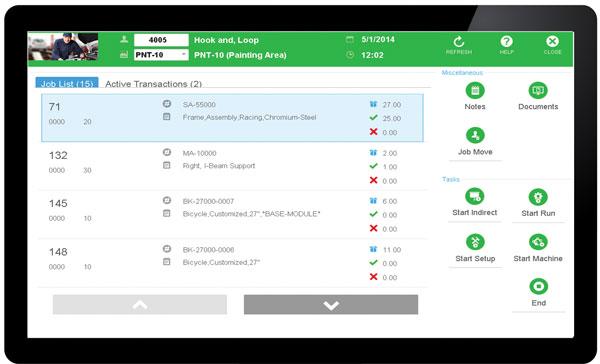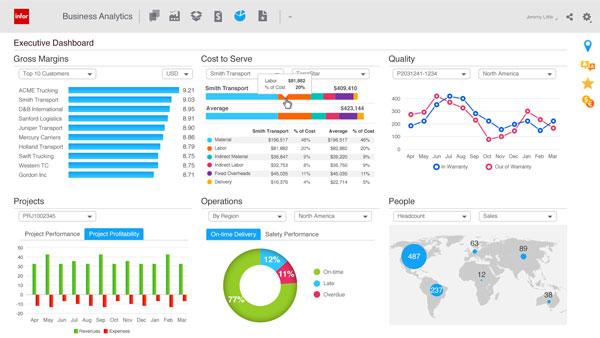- FMA
- The Fabricator
- FABTECH
- Canadian Metalworking
Bridging the Gap
Modern IT systems optimize production by linking back-office planning with the shop floor
- By Larry Korak
- December 5, 2014
- Article
- Management

ERP software specifically designed for manufacturing tracks jobs through each process from the raw material stage to shipping.
In many manufacturing plants the role of the enterprise resource planning (ERP) system abruptly halts at the shop floor.
Like throwbacks from another era, wall-mounted job boards, magnets, and thumbtacks are the tools used to track production workflows and machine assignments. Shop foremen, armed with clipboards and time stamps, track labor and parts in rushed guesses at the end of shifts. Machine operators consult bulky plastic pouches—the job packets— for relevant paperwork, customer orders, bills of material, component schematics, and labels for shipping the finished goods. And, sometimes, a last-minute customer change might be scribbled on a note, paper-clipped to the bundle.
Despite widespread process improvements, the factory shop floor is often the last bastion of the manufacturing operation to become fully modernized and integrated with the ERP system. IT providers must acknowledge some of the responsibility. Early ERP systems often tried to take a one-size-fits-all approach to managing businesses, offering retailers, contractors, and manufacturers the same generic functionality.
It’s no wonder manufacturers developed their own methods for assigning jobs to machines, picking and packing orders in the warehouse, and estimating labor. Homegrown software and loosely bundled point systems, each managing highly specialized tasks, frequently filled the gap between the back-office accounting department and the shipping dock. Although self-developed systems match the company’s workflow, they often lack the advanced functionality that a modern technology offers.
Third-party point solutions also have been used as a stop-gap vehicle by some manufacturers desperate for ways to streamline processes.
This manner of working, although limited, does offer an improvement over purely manual job boards and packets, but often lacks the visibility that a truly integrated system offers. Without built-in integration to the ERP system, visibility to costs and analytical capabilities are severely limitedDisconnected systems also make it difficult to predict available capacity, product delivery schedules, and raw goods that need replenished. Departmental silos mean gaps, delays, and multiple versions of spreadsheets, outdated as soon as they are printed with versions of data that seldom match.
Modern Technology
Today manufacturers have learned that such disparate tools limit their ability to view total costs and respond proactively to fast-changing customer demands. To be competitive, manufacturers need a real-time view of the entire workflow, including every machine and process on the factory floor, from tooling to finishing, inspection, and packing.
Some IT providers have stepped up to the challenge and answered the call of manufacturers. Modern technology provides vertical industry features and offers tools to manage operational processes with the precision, agility, and automation that managers today need. Now the complex synchronization of the shop floor can be managed with greater ease, speed, and attention to productivity.
ERP systems can manage shop floor processes in many ways, including:
•Role-based dashboards. These allow business managers and shift foremen to monitor key performance indicators (KPIs) for critical profit-influencing factors, such as cycle turns, completed goods, orders shipped as promised, and workforce productivity.
•Automatic escalation alerts. These alerts can be set to immediately notify managers when an event threatens timely fulfillment of a customer order or completion of the job within predefined cost restraints.
•Shop floor scheduling tools. With these, managers can experiment with the best orchestration of jobs-to-machines to maximize run times and prevent machines from sitting idle.
•Integrated labor tracking. Tracking helps managers accurately monitor costs of personnel working on the line as well as the warehouse and analyze profitability of accounts, which is important to future quoting.
•Job detail view. Full visibility of job details eliminates the outdated job packet concept, allowing realtime tracking of complete details of the customer order with the ability to drill down into historical activities, contract agreements, and collaborative conversations.
•Cost tracking. Easy-to-use tools help shop floor managers record time, parts, resources, and labor according to each customer job, resulting in more accurate billing.
•MTO management. Complex on demand and make-to-order (MTO) jobs are easier to manage when the details of customer configurations, schematics, 3-D models, and collaborative conversations can be tracked in real time. On any machine or step along the completion cycle, personnel can drill down into details of the project. Last-minute variations can be tracked for accurate traceability, billing, and future quoting.
•Quality control. Consistent quality control can be easier to achieve with an integrated quality control system, which allows shop floor managers to access product specifications, confirm any last-minute product changes, and turn to integrated collaboration tools to communicate questions or unexpected delays to account managers and customers.
•Inventory tracking. Inventory accuracy is improved when the handoff of goods from the production line to the warehouse is managed with one system. Integration means a continuous flow of data, tracking completion of jobs and when finished goods can be transferred to ready-toship status. This timely notice helps logistics teams to expedite shipments to customers and meet as-promised schedules.

Business analytics can be viewed in a single dashboard that gives an overview of a company’s overall status.
•Material flow. Material movement can be tracked, updated, and accessed from any location in the plant, allowing managers to monitor progress and project completion and answer customer questions with accuracy.
•JIT. Kanban strategies can be executed with greater ease and flexibility, allowing companies to use purchase orders, just-in-time stocking, or material movement to maintain appropriate inventory levels.
•Data accessing. Remote devices with touchscreens can be used on the shop floor, mounted in accessible but secure places, so personnel can retrieve critical data, with the convenience of hand-held or rugged devices but with all the power of traditional PCs.
•Picking, packing, and shipping. These tasks in the warehouse are easier to manage with a fully integrated system, which seamlessly connects orders placed, customer relationship management (CRM) systems, product dependencies, and logistics systems. This ensures that the correct installation kits are packaged with the right equipment and that any required accessories are also shipped at the same time.
•Maintenance. Equipment maintenance can be scheduled for the least disruption to critical workflows and customer order completions. Full visibility into the shop floor schedules and order requirements allows maintenance teams to orchestrate the best timing for equipment maintenance.
The common benefit of modern ERPs is that integration provides greater visibility, which in turn promotes agile reactions and well-informed decisions.
Personnel throughout the organization can view critical shop floor data and use this data to make strategic decisions that will favorably affect the customer, building loyalty. Proactive decisions also can be made to enhance profitability. While on the surface tying the ERP system to the shop floor operations seems simplistic, the impact is dynamic and far-reaching.
This basic combination of speed and fact-based decision-making gives manufacturers the competitive edge they so desperately need today. The chasm between the planning and execution stage can, finally, be a relic of the past, along with the plywood job board and bulging plastic job packets.
subscribe now


Keep up to date with the latest news, events, and technology for all things metal from our pair of monthly magazines written specifically for Canadian manufacturers!
Start Your Free Subscription- Trending Articles
- Industry Events
MME Winnipeg
- April 30, 2024
- Winnipeg, ON Canada
CTMA Economic Uncertainty: Helping You Navigate Windsor Seminar
- April 30, 2024
- Windsor, ON Canada
CTMA Economic Uncertainty: Helping You Navigate Kitchener Seminar
- May 2, 2024
- Kitchener, ON Canada
Automate 2024
- May 6 - 9, 2024
- Chicago, IL
ANCA Open House
- May 7 - 8, 2024
- Wixom, MI















